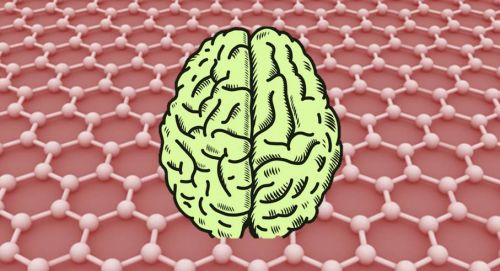
11/01/2019
Graphene-based implant developed by IMB and ICN2 on UAB campus records brain activity
Graphene-based implant developed by IMB and ICN2 on UAB campus records brain activity
In the graphite tip of a pencil, carbon atoms are arranged in a layered, planar structure forming a honeycomb lattice. Graphene is one of these sheets with only one atom thick.
Within a few years, graphene has become the prime example of a promising material for its numerous properties: resistant and light, flexible and elastic, transparent, conductor of heat and electricity, etc. Graphene has already been awarded a Nobel Prize in 2010 and Graphene Flagship is one of the two current key scientific initiatives of the European Union (Humain Brain Project is the other one) that gathers 142 academic and industrial groups from 23 different countries with 1 billion Euros in funding over the 2013-2023 period.
In this context, researchers in Barcelona have developed a graphene-based implant able to record electrical activity in the brain at extremely low frequencies and over large areas. The prototype was developed at the Barcelona Microelectronics Institute (IMB-CNM, CSIC) and the Catalan Institute of Nanoscience and Nanotechnology (ICN2, a BIST and CSIC centre), both on the Barcelona Synchrotron Park’s UAB campus partner, and was adapted for brain recordings in collaboration with the August Pi i Sunyer Biomedical Research Institute (IDIBAPS).
Published in Nature Materials, the ground-breaking technology promises to enhance the understanding of the brain and pave the way for the next generation of brain-computer interfaces.
More information
Within a few years, graphene has become the prime example of a promising material for its numerous properties: resistant and light, flexible and elastic, transparent, conductor of heat and electricity, etc. Graphene has already been awarded a Nobel Prize in 2010 and Graphene Flagship is one of the two current key scientific initiatives of the European Union (Humain Brain Project is the other one) that gathers 142 academic and industrial groups from 23 different countries with 1 billion Euros in funding over the 2013-2023 period.
In this context, researchers in Barcelona have developed a graphene-based implant able to record electrical activity in the brain at extremely low frequencies and over large areas. The prototype was developed at the Barcelona Microelectronics Institute (IMB-CNM, CSIC) and the Catalan Institute of Nanoscience and Nanotechnology (ICN2, a BIST and CSIC centre), both on the Barcelona Synchrotron Park’s UAB campus partner, and was adapted for brain recordings in collaboration with the August Pi i Sunyer Biomedical Research Institute (IDIBAPS).
Published in Nature Materials, the ground-breaking technology promises to enhance the understanding of the brain and pave the way for the next generation of brain-computer interfaces.
More information
More news
07/05/2014
The new Hewlett-Packard world development center for 3D printers will be in Barcelona
28/04/2014
Loss of memory reversed in Alzheimer's mice models
25/04/2014
More than 30 companies attended the ALBA industry workshop
15/04/2014
European Commission names Barcelona first European Capital of Innovation
11/04/2014
Visit of the Spanish State Secretary for research to the Barcelona Synchrotron Park (BSP)
02/04/2014
High-precision molding in the PTV









